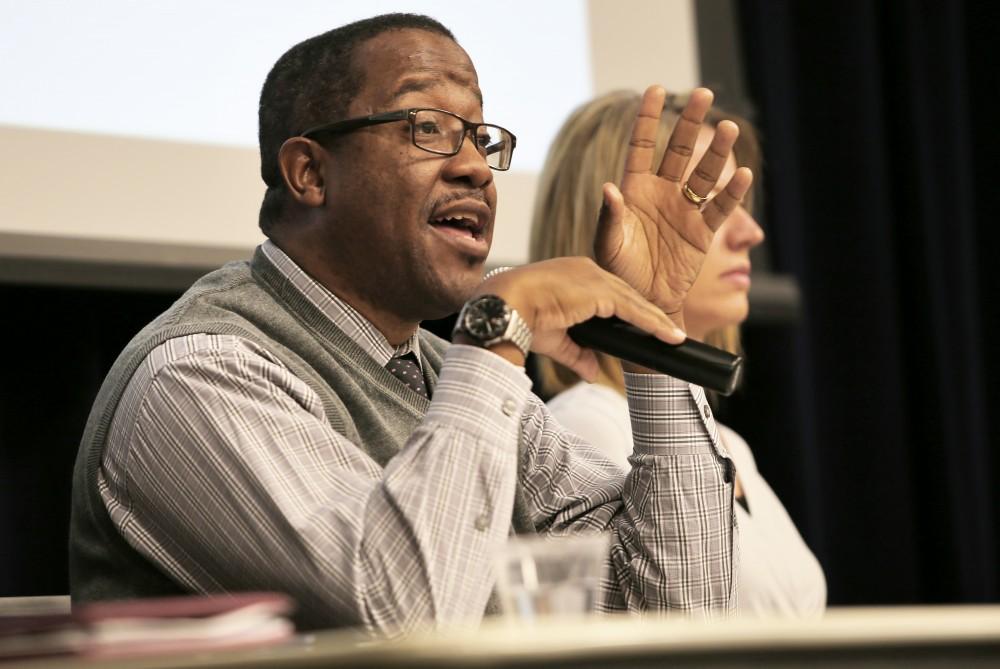Inclusion and Equity assesses sexual misconduct policy

GVL/Kevin Sielaff Dwight Hamilton
Jan 26, 2015
As awareness grows and more accounts of sexual misconduct are reported at Grand Valley State University, the Office of Inclusion and Equity reflected on some of the key changes enacted in the new interim sexual misconduct policy that was established in November of 2014 and the importance of raising attention to such incidents on campus.
Dwight Hamilton, GVSU Title IX officer, said reasons for the increase in reports on campus could be due to heightened awareness, training of staff and students as well as the publishing of the new interim sexual misconduct policy.
“The biggest difference in this policy is that it really pulls out the investigation, adjudication and discipline for sexual misconduct, which we have defined as sexual assault, dating domestic violence and stalking, outside of the general student code of conduct,” Hamilton said.
The incorporation of a Title IX investigator is new to the process, Hamilton said.
In the investigation process of a sexual misconduct incident, the victim/survivor and the accused both have separate interviews with the investigator where they have the opportunity to introduce any information that is relevant to the investigation, Hamilton said.
“Before the (investigator) issues a finding, there will be a summary of the evidence received throughout the investigation and both the victim/survivor and the accused have access to that and will have the opportunity to respond,” Hamilton said. “Once that finding is made, it is taken to the conduct office. If there is a finding of a violation of the sexual misconduct policy, the next step is determining appropriate sanctions, and that sanction will be rendered consistent with the totality of the situation itself.”
Bart Merkle, vice provost for Student Affairs, said the new interim sexual misconduct policy has also changed the investigation process for off-campus incidents.
“There was a time in the past where if someone reported a sexual assault (or any event) off-campus, we didn’t tend to get involved investigating it,” Merkle said. “So we’ve evolved in a way that we do now. If a student comes in to Dwight’s office and reports a sexual assault, if the student wants it to be investigated, it’s going to be investigated.”
Hamilton noted that the new interim sexual misconduct policy is just a part of many awareness-raising actions that the university has undertaken to create a more comfortable environment for GVSU students.
“There’s lots of training,” Hamilton said. “We have outside and internal speakers, we speak to specific student groups, and we’ve done training with members of our fraternities, athletes as well as student organizations like Eyes Wide Open.”
“We are trying to get this information out as broadly and as often as possible. What we want to do is have people know what resources are available and what the expectations are for whether you are a person who experienced sexual misconduct or you’ve been accused of committing sexual misconduct.”
Marlene Kowalski-Braun, assistant vice provost for Student Affairs, said the word of mouth on GVSU’s prevention and response teams has also helped in creating awareness.
“We have a campus violence prevention team that started four and half years ago, as well as a sexual assault response team,” Kowalski-Braun said. “The former is made up of a lot of campus and community partners that aims to get the message out broadly. The latter is working at making sure that our systems are working so that a student doesn’t experience miscommunication and unnecessary time lags. They are very much looking at our internal processes.”
Hamilton said there is no word on when the final sexual misconduct policy will be created, but there will be a survey sent out to campus that will be directed toward students’ experiences with sexual misconduct.
In reference to finalizing the sexual misconduct policy, Hamilton said it’s a non-stop process.
“This is not a static work,” Hamilton said. “This is a continual evolution, improvement, revision and examination.”





















